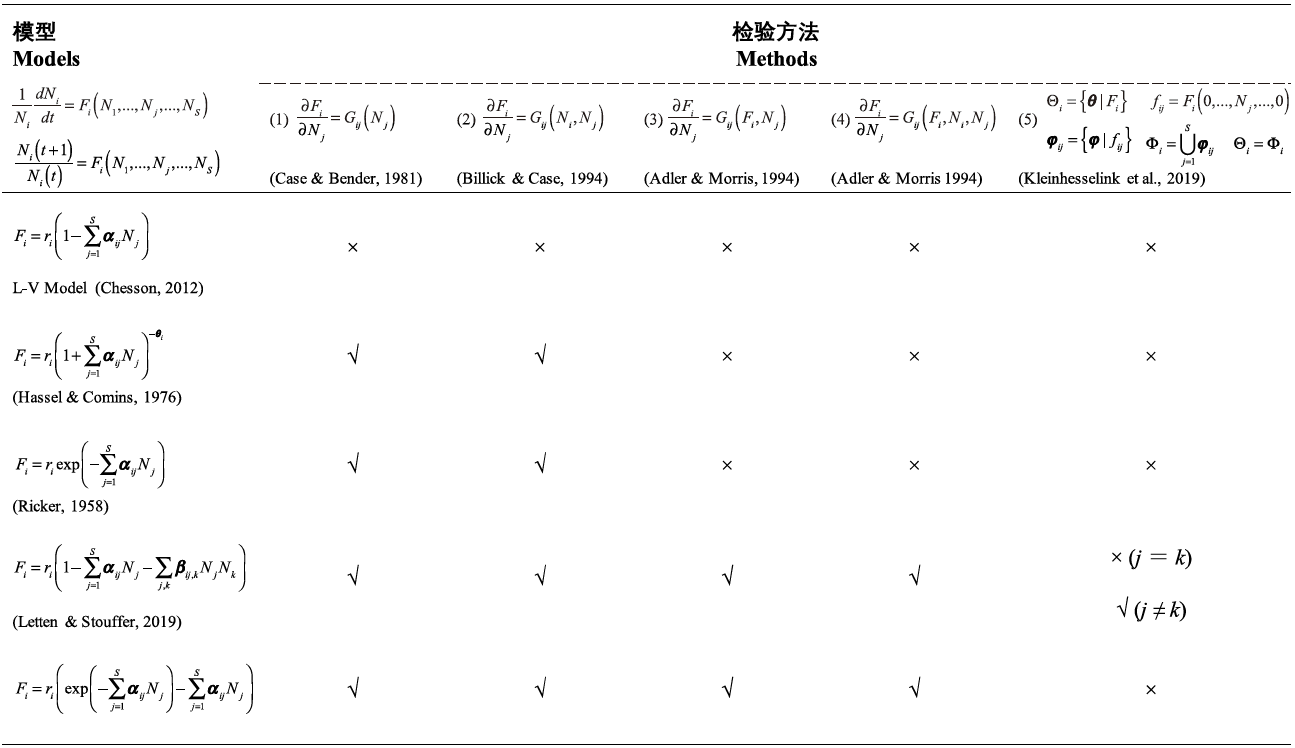生物间高阶相互作用研究进展
Advances in higher-order interactions between organisms
 |
生物间高阶相互作用研究进展 |
|
| 李远智, 肖俊丽, 刘翰伦, 王酉石, 储诚进 | |
|
Advances in higher-order interactions between organisms |
|
| Yuanzhi Li, Junli Xiao, Hanlun Liu, Youshi Wang, Chengjin Chu | |
| 表1 检验模型是否包含狭义高阶相互作用的方法及部分常见模型检验结果。√表示模型中包含狭义高阶相互作用(模型不满足方法中等式), ×表示模型不含狭义高阶相互作用(模型满足方法中等式)。这些方法旨在将狭义高阶相互作用从广义高阶相互作用中区分出来, 其中(1)、(3)和(5)用于检验两物种或两物种以上系统是否包含狭义高阶相互作用, (2)和(4)分别是(1)和(3)用于将狭义高阶相互作用严格定义在三物种或三物种以上系统中时的情况, 因而方法(1)和(2), (3)和(4)在三个以上物种组成的系统中等效。Fi表示物种i的单位种群增长率是其自身及竞争者密度的函数, 这里给出几个常见模型的Fi函数表达式。如果函数Fi对Nj的偏导数?Fi/?Nj能表达成Nj的函数Gij(Nj) (方法1), 或是Ni和Nj的函数Gij(Ni, Nj) (方法2), 或是Nj和Fi自身的函数Gij(Fi, Nj) (方法3), 或是Ni和Nj以及Fi的函数Gij(Fi, Ni, Nj) (方法4), 则模型没有狭义高阶相互作用。方法(5)中, Qi表示函数Fi中所有参数的集合, jij表示除物种j外所有物种的密度均为0时函数Fi(0, …, Nj, …, 0)中的参数, Fi则是jij (j = 1, …, S)的并集。若Qi = Fi, 则模型没有狭义高阶相互作用。 |
|
| Table 1 The methods of detecting whether a species interaction model contains hard higher-order interactions (hard-HOIs) and the outcomes of some well known models. √ and × indicate the model contains (the equation in a method is violated) and does not contain (the equation in a mothed is satisfied) hard-HOIs, respectively. Methods (1), (3) and (5) are used in the case of HOIs defined in systems of two or more species, and methods (2) and (4) are special cases of (1) and (3) where HOIs are strictedly defined in systems of three or more species. Fi indicates the per capita growth rate of species i as a function the densities of itself and its competitiors. If the partial derivative of Fi to Nj (?Fi/?Nj) can be expressed as only a function of Nj: Gij(Nj) (method 1), or a function of Ni and Nj: Gij(Ni, Nj) (method 2), or function of Nj and Fi: Gij(Fi, Nj) (method 3), or a function of Ni, Nj and Fi: Gij(Fi, Ni, Nj) (method 4), then the model Fi does not contain hard-HOIs according to methods 1-4, respectively. In method (5), Qi indicates the set of paramters in function Fi; jij indicates the set of parameters in function Fi(0, …, Nj, …, 0) when densities of all species are zero except species j; Fi is the union of jij (j = 1, …, S). If Qi = Fi, then the model Fi does not contain hard-HOIs. |
|
|
|